General Description
Key Features
Applications
Key Benefits
System Diagram
Contents
Figures
Tables
1 Block Diagram
2 Packages and Pinout
2.1 WLCSP17
2.2 FCGQFN24
3 Specifications
3.1 Absolute Maximum Ratings
3.2 Recommended Operating Conditions
3.3 DC Characteristics
3.4 Timing Characteristics
3.5 RCX Oscillator
3.6 XTAL32MHz Oscillator
3.7 XTAL32kHz Oscillator
3.8 RC32MHz Oscillator
3.9 DC-DC Converter
3.10 LDO_LOW Characteristics
3.11 Digital I/O Characteristics
3.12 Power On Reset
3.13 GP ADC
3.14 Temperature Sensor
3.15 Radio
4 System Overview
4.1 Internal Blocks
4.2 Power Management Unit
4.2.1 Introduction
4.2.2 Architecture
4.2.2.1 Digital Power Domains
4.2.2.2 Power Modes
4.2.2.3 VDD Level in Hibernation
4.2.2.4 Retainable Registers
4.2.3 Programming
4.2.3.1 Buck Configuration
4.2.3.2 Boost Configuration
4.2.3.3 Bypass Configuration
4.3 HW FSM (Power-up, Wake-up, and Go-to-Sleep)
4.3.1 Power-up/Wake-up in Buck Configuration
4.3.2 Power-up/Wake-up in Boost Configuration
4.3.3 Go-to-Sleep and Refresh Bandgap
4.4 OTP Memory Layout
4.4.1 OTP Header
4.4.2 Configuration Script
4.5 BootROM Sequence
5 Reset
5.1 Introduction
5.2 Architecture
5.2.1 POR, HW, and SW Reset
5.2.2 POR Functionality
5.2.2.1 POR Timer Clock
5.2.2.2 RST Pad
5.2.2.3 POR from GPIO
5.2.3 POR Timing Diagram
5.2.4 POR Considerations
5.3 Programming
6 Arm Cortex-M0+
6.1 Introduction
6.2 Architecture
6.2.1 Interrupts
6.2.2 System Timer (systick)
6.2.3 Wake-Up Interrupt Controller
6.3 Programming
7 AMBA Bus
7.1 Introduction
7.2 Architecture
7.3 Programming
8 Memory Map
9 Memory Controller
9.1 Introduction
9.2 Architecture
9.2.1 Arbitration
10 Clock Generation
10.1 Clock Tree
10.1.1 General Clock Constraints
10.2 Crystal Oscillators
10.2.1 Frequency Control (32 MHz Crystal)
10.2.2 Automated Trimming and Settling Notification
10.3 RC Oscillators
10.3.1 Frequency Calibration
11 OTP Controller
11.1 Introduction
11.2 Architecture
11.2.1 OTP Accessing Considerations
11.3 Programming
12 DMA Controller
12.1 Introduction
12.2 Architecture
12.2.1 DMA Peripherals
12.2.2 Input/Output Multiplexer
12.2.3 DMA Channel Operation
12.2.4 DMA Arbitration
12.2.5 Freezing DMA Channels
12.3 Programming
12.3.1 Memory to Memory Transfers
12.3.2 Peripheral to Memory Transfers
13 I2C Interface
13.1 Introduction
13.2 Architecture
13.2.1 I2C Bus Terms
13.2.1.1 Bus Transfer Terms
13.2.2 I2C Behavior
13.2.2.1 START and STOP Generation
13.2.2.2 Combined Formats
13.2.3 I2C Protocols
13.2.3.1 START and STOP Conditions
13.2.3.2 Addressing Slave Protocol
7-bit Address Format
10-bit Address Format
13.2.3.3 Transmitting and Receiving Protocols
Master-Transmitter and Slave-Receiver
Master-Receiver and Slave-Transmitter
START BYTE Transfer Protocol
13.2.4 Multiple Master Arbitration
13.2.5 Clock Synchronization
13.3 Programming
14 UART
14.1 Introduction
14.2 Architecture
14.2.1 UART (RS232) Serial Protocol
14.2.2 Clock Support
14.2.3 Interrupts
14.2.4 Programmable THRE Interrupt
14.2.5 Shadow Registers
14.2.6 Direct Test Mode
14.3 Programming
15 SPI Interface
15.1 Introduction
15.2 Architecture
15.2.1 SPI Timing
15.3 Programming
15.3.1 Master Mode
15.3.2 Slave Mode
16 Quadrature Decoder
16.1 Introduction
16.2 Architecture
16.3 Programming
17 Clockless Wakeup Controller
17.1 Introduction
17.2 Architecture
17.3 Programming
18 Clocked Wakeup Controller
18.1 Introduction
18.2 Architecture
18.3 Programming
19 Timer 0
19.1 Introduction
19.2 Architecture
19.3 Programming
19.3.1 Timer Functionality
19.3.2 PWM Generation
20 Timer 1
20.1 Introduction
20.2 Architecture
20.3 Programming
20.3.1 Timer Functionality
20.3.2 Capture Functionality
20.3.3 Frequency Measuring Functionality
21 Timer 2
21.1 Introduction
21.2 Architecture
21.3 Programming
21.3.1 PWM Generation
21.3.2 Freeze Functionality
22 Watchdog Timer
22.1 Introduction
22.2 Architecture
22.3 Programming
23 Temperature Sensor
23.1 Introduction
23.2 Architecture
23.2.1 Programming
23.2.1.1 Absolute Temperature
23.2.1.2 Relative Temperature
24 Keyboard Controller
24.1 Introduction
24.2 Architecture
24.2.1 Keyboard Scanner
24.2.2 GPIO Interrupt Generator
24.3 Programming
24.3.1 Keyboard Scanner
24.3.2 GPIO Interrupts
25 Input/Output Ports
25.1 Introduction
25.2 Architecture
25.2.1 Programmable Pin Assignment
25.2.1.1 Priority
25.2.1.2 Direction Control
25.2.2 General Purpose Port Registers
25.2.2.1 Port Data Register
25.2.2.2 Port Set Data Output Register
25.2.2.3 Port Reset Data Output Register
25.2.3 Fixed Assignment Functionality
25.2.4 Types of GPIO Pads
25.2.5 Driving Strength
26 General Purpose ADC
26.1 Introduction
26.2 Architecture
26.2.1 Input Channels
26.2.2 Operating Modes
26.2.2.1 Enabling the ADC
26.2.2.2 Manual Mode
26.2.2.3 Continuous Mode
26.2.3 Conversion Modes
26.2.3.1 AD Conversion
Sampling Phase
Conversion and Storage Phase
26.2.3.2 Averaging
26.2.3.3 Chopper Mode
26.2.4 Additional Settings
26.2.5 Non-Ideal Effects
26.2.6 Offset Calibration
26.2.7 Zero-Scale Adjustment
26.2.8 Common Mode Adjustment
26.2.9 Input Impedance, Inductance, and Input Settling
26.3 Programming
27 Real Time Clock (RTC)
27.1 Introduction
27.2 Architecture
27.3 Programming
28 Power
28.1 DCDC Converter
28.2 LDOs
28.3 POR Circuit
29 BLE Core
29.1 Architecture
29.1.1 Exchange Memory
29.2 Programming
29.2.1 Wake-Up IRQ
29.2.2 Switch from BLE Active Mode to BLE Deep Sleep Mode
29.2.3 Switch from BLE Deep Sleep Mode to BLE Active Mode
29.2.3.1 Switching at an Anchor Point
29.2.3.2 Switching Due to an External Event
30 Radio
30.1 Introduction
30.2 Architecture
30.2.1 Receiver
30.2.2 Synthesizer
30.2.3 Transmitter
30.2.4 RFIO
30.2.5 Biasing
30.2.6 RF Monitoring
31 Registers
31.1 Analog Miscellaneous Registers
31.2 BLE Core Registers
31.3 Clock Generation and Reset Registers
31.4 DCDC Converter Registers
31.5 DMA Controller Registers
31.6 General Purpose ADC Registers
31.7 General Purpose I/O Registers
31.8 General Purpose Registers
31.9 I2C Interface Registers
31.10 Keyboard Registers
31.11 Miscellaneous Registers
31.12 OTP Controller Registers
31.13 Quadrature Decoder Registers
31.14 Real Time Clock Registers
31.15 SPI Interface Registers
31.16 Timer and Triple PWM Registers
31.17 Timer1 Registers
31.18 UART Interface Registers
31.19 Chip Version Registers
31.20 Wake-Up Registers
31.21 Watchdog Registers
32 Ordering Information
33 Package Information
33.1 Moisture Sensitivity Level (MSL)
33.2 WLCSP Handling
33.3 Soldering Information
33.4 Package Outlines
Revision History
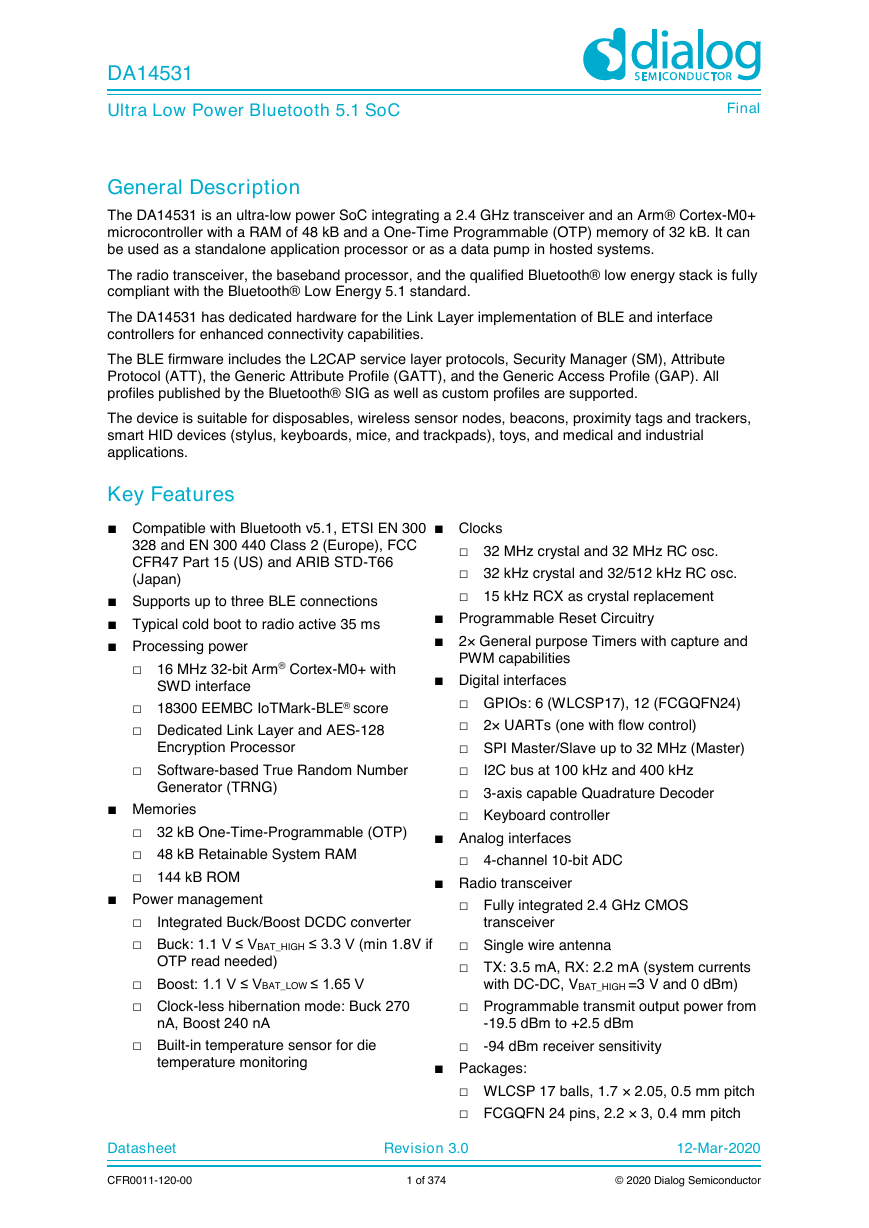

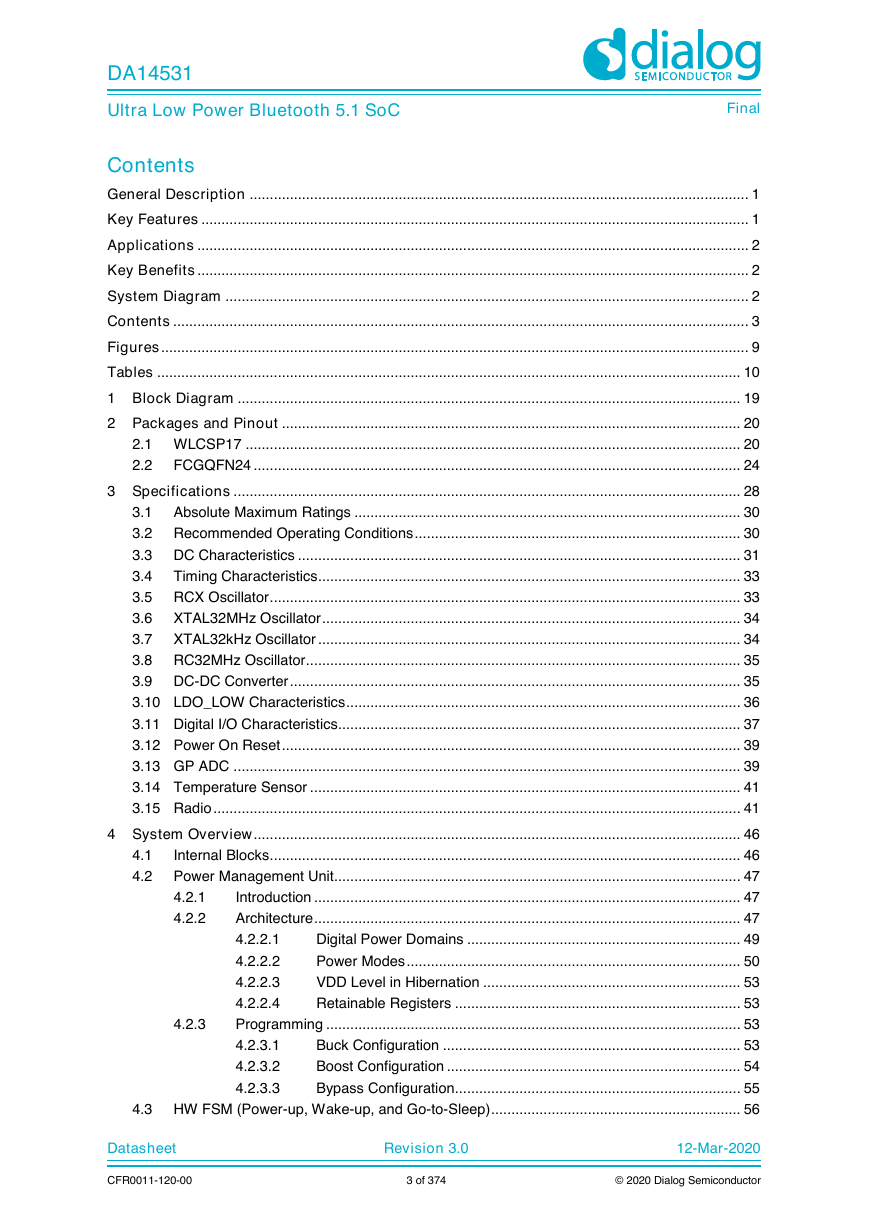
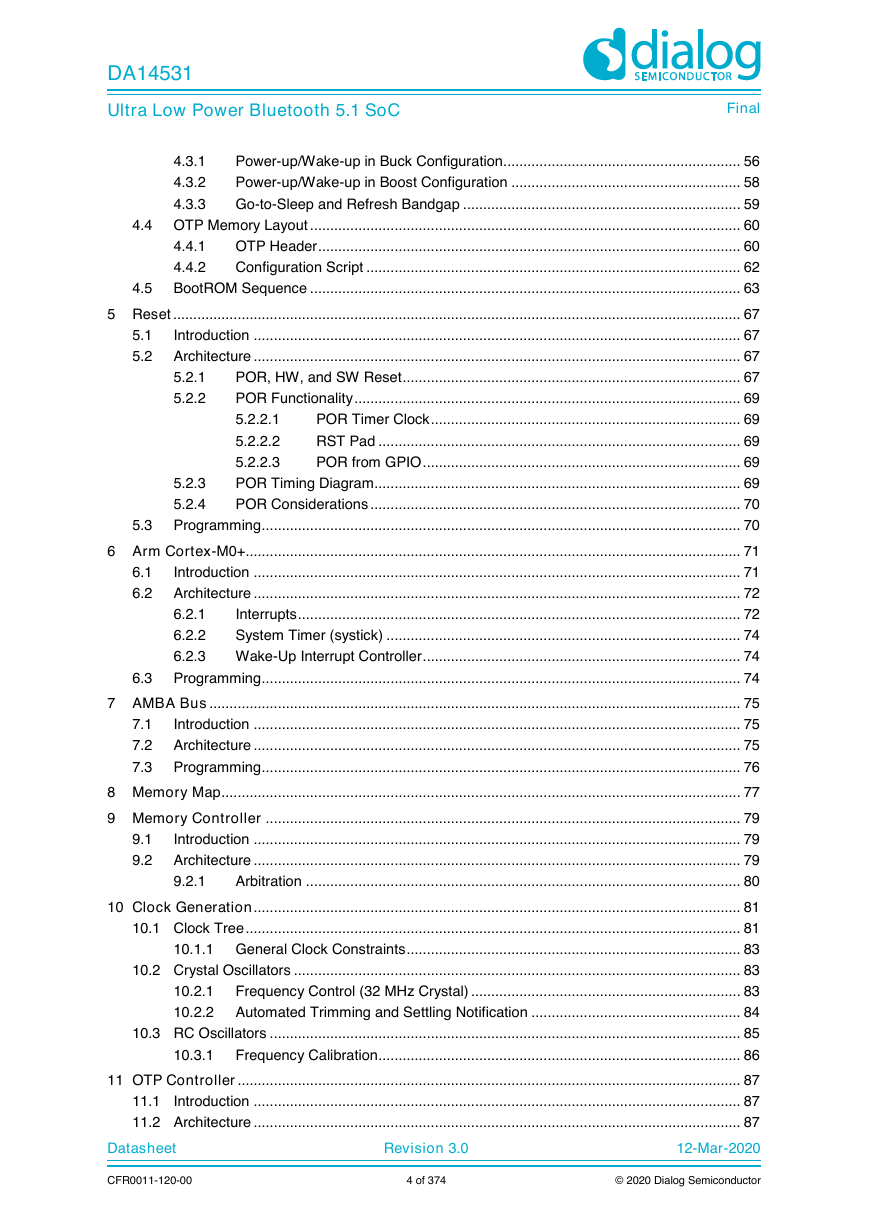
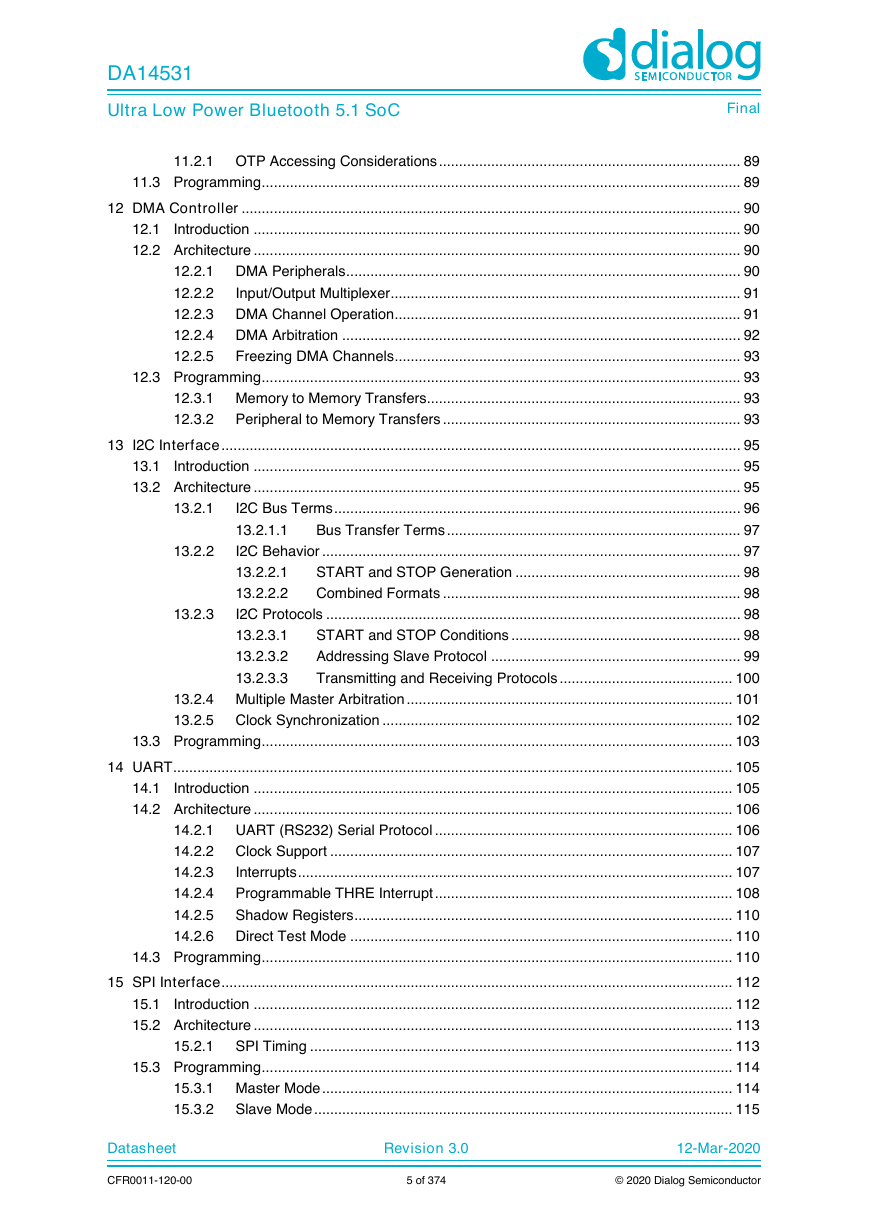
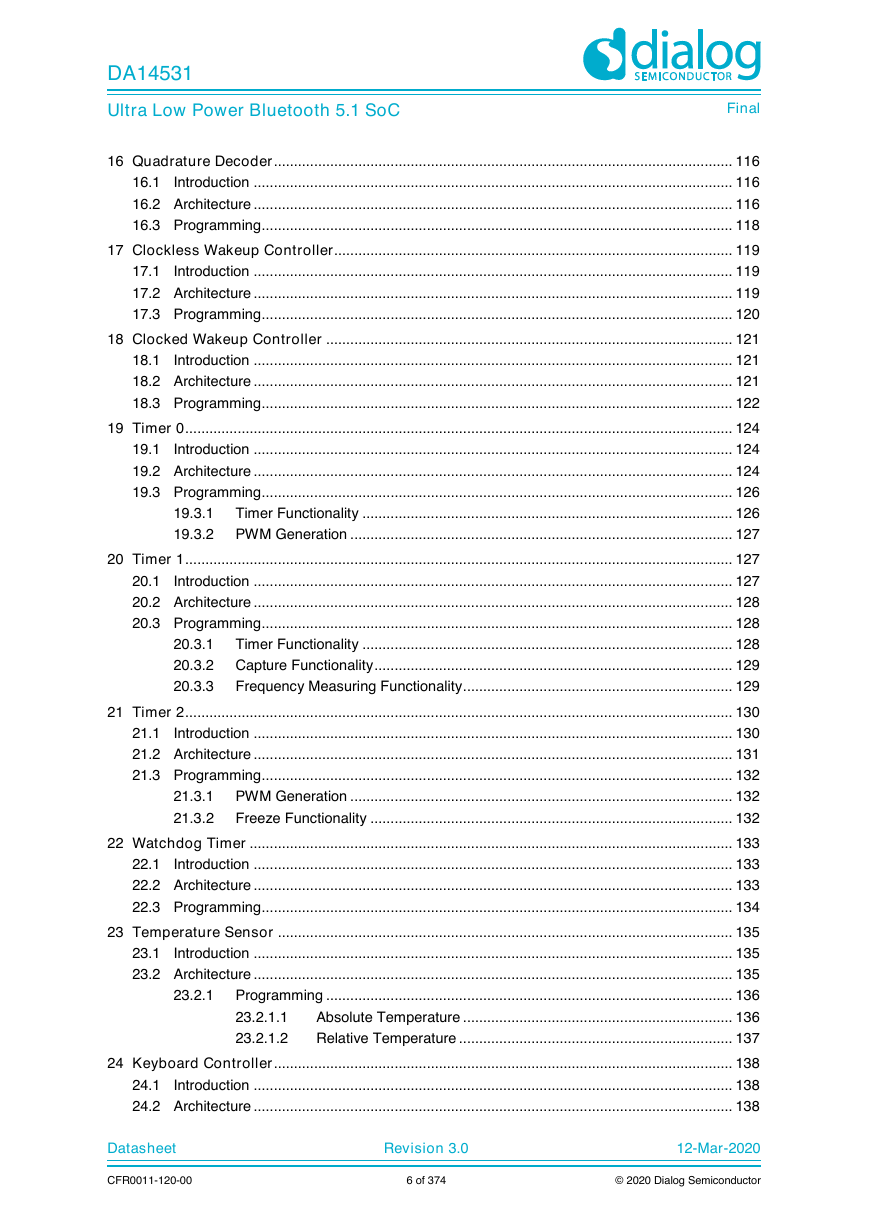

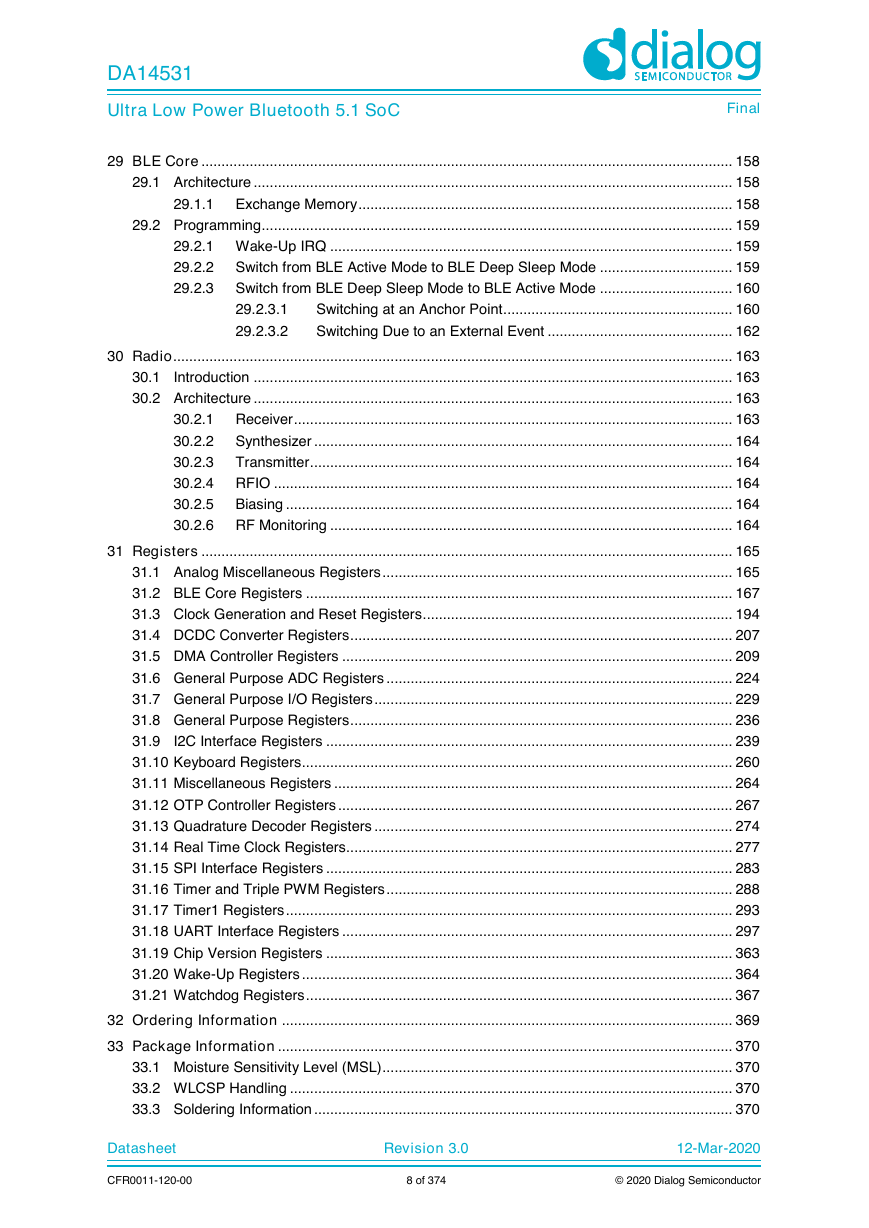








 2023年江西萍乡中考道德与法治真题及答案.doc
2023年江西萍乡中考道德与法治真题及答案.doc 2012年重庆南川中考生物真题及答案.doc
2012年重庆南川中考生物真题及答案.doc 2013年江西师范大学地理学综合及文艺理论基础考研真题.doc
2013年江西师范大学地理学综合及文艺理论基础考研真题.doc 2020年四川甘孜小升初语文真题及答案I卷.doc
2020年四川甘孜小升初语文真题及答案I卷.doc 2020年注册岩土工程师专业基础考试真题及答案.doc
2020年注册岩土工程师专业基础考试真题及答案.doc 2023-2024学年福建省厦门市九年级上学期数学月考试题及答案.doc
2023-2024学年福建省厦门市九年级上学期数学月考试题及答案.doc 2021-2022学年辽宁省沈阳市大东区九年级上学期语文期末试题及答案.doc
2021-2022学年辽宁省沈阳市大东区九年级上学期语文期末试题及答案.doc 2022-2023学年北京东城区初三第一学期物理期末试卷及答案.doc
2022-2023学年北京东城区初三第一学期物理期末试卷及答案.doc 2018上半年江西教师资格初中地理学科知识与教学能力真题及答案.doc
2018上半年江西教师资格初中地理学科知识与教学能力真题及答案.doc 2012年河北国家公务员申论考试真题及答案-省级.doc
2012年河北国家公务员申论考试真题及答案-省级.doc 2020-2021学年江苏省扬州市江都区邵樊片九年级上学期数学第一次质量检测试题及答案.doc
2020-2021学年江苏省扬州市江都区邵樊片九年级上学期数学第一次质量检测试题及答案.doc 2022下半年黑龙江教师资格证中学综合素质真题及答案.doc
2022下半年黑龙江教师资格证中学综合素质真题及答案.doc